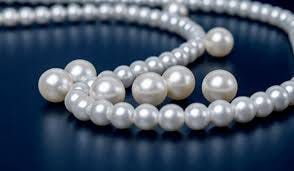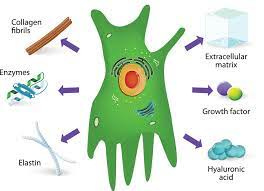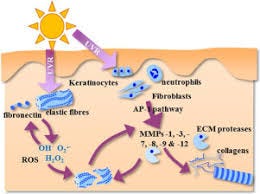INTRODUCTION
The Beauty from Within market is a supplement industry sector that is growing at an enviable, consistent pace. However, like many aspects of nutrition and natural products, current offerings vary in value and present gaps in terms of validation and efficacy. The science that underlies matrix health is often pushed back by aggressive marketing plans focused on hopefulness and emotions. Who does not want to look their best? Often that message is all that is needed.
The goals of this article is help define these gaps and identify how best to optimize skin health. In other words, how to truly make your collagen supplement sing. To do this we must unravel the layers of physiology, biochemistry and molecular biology that establish the rules of play.
WHAT HAPPENS WHEN I INGEST A COLLAGEN SUPPLEMENT?
Collagen is a family of proteins (at least 28 different forms) and during its construction there are a lot of cross-bridges connecting the “strands” together. This rather unique construction is modified in each tissue in terms of the profile of collagen forms that are interconnected to provide the necessary form and function for that tissue. Collagen is quite strong and resilient, but with that it is also hard to digest. Anyone who has tried to eat the keel of a chicken breastbone knows that.
Ingredient suppliers overcome this problem by partially digesting collagen protein into peptides (fragments of the protein). This also provides additional applications because unlike collagen protein, the peptides can be made water soluble, and from this beverage applications are viable.
Once ingested the collagen supplement (peptides) are further broken down by the digestive system into amino acids. In the rank order of mass, proteins are made of peptides, and peptides are made from amino acids. Think of it like a PEARL NECKLACE
· An intact pearl necklace being the protein
· A piece of broken strand being a peptide
· And individual pearls are the equivalent of amino acids.
With some rare exceptions, the collagen supplement that is ingested makes its way to the skin in the form of individual amino acids or pearls. The next step is to remake a Pearl Necklace from the amino acids that are being delivered in the circulation.
This is a critical process, and the basis for the title of the article.
“Why are collagen supplements like Ikea Furniture? Because construction is required!”
However, just delivering these amino acids is not a Gold Pass to making collagen (in its various forms) because making the protein is tightly regulated. The switch dictating Collagen production is not permanently ON and simply awaits the delivery of the amino acids. That scenario simply does not exist.
The act of making collagen or any protein is determined by the presence and activity enzymes that code for that protein. These enzymes, or processes, are activated on a need be basis, and are turned off (into dormancy) when they are not needed. Each form of collagen has its own enzyme (gene) that codes for its construction.
Returning to the IKEA furniture analogy, the mere delivery of amino acids does not mean you get new collagen. Just like when a box of Ikea furniture arrives all you have is a box. You do not have a bookcase or a table or whatever you require. What is needed is assembly of the parts to achieve the desired end-product.
In what I call 1st Generation Collagen supplements, there is nothing in the collagen product that helps in the assembly process. What is delivered is a box of furniture parts without instructions. With that there is a degree of hopefulness that the body will know what to do with these parts. Have you tried to construct furniture without looking at the instructions. Okay, most males have tried to do that, but how was the outcome?
Without recruiting a process/enzyme to assemble the collagen, the mere delivery of the parts does not mean you get more collagen. Maybe you will, maybe you will not. It truly is like getting the box of Ikea furniture without instructions – best of luck.
This is where we stand for the vast majority of the collagen industry. The results are variable, and some consumers are left wanting more. You will see marketing efforts to deflect from this flaw. Usually, they discuss the differences in origin (marine vs bovine vs chicken etc.) or the type of collagen, as a means of differentiating from their competition. However, that is just noise. You might as well play with the Cardboard Box the furniture came in and built a “fort” out of it. For this reason, you will note that these 1st Generation Collagen products lack any clinical trial support for the desired outcomes.
CONSTRUCTING COLLAGEN: ASSEMBLING THE FURNITURE
There are some collagen peptides that have been engineered to do 2 advantageous things:
1. Get absorbed as peptides
2. Stimulate fibroblasts to make collagen.
This goes a long way to helping build the Ikea furniture that was ordered, but while these very specific, branded collagen peptides they do assist in constructing collagen by providing the instructions to fibroblasts. However, their “gain’ is small. What this means is that the process is active, but it’s not functioning at full speed. Think of your teenager given the instructions and job of constructing he furniture. It may be great but some people need more skilled help.
This approach, of specific collagen peptides to augment fibroblasts represents 2nd Generation Collagen products. It is most certainly an advancement of 1st Generation. You may also find that there may be other components/ingredients in these 2nd Generation products that bring value beyond the skin. That is indeed helpful, and a clear point of differentiation, but there is much more that can be done for skin health and Beauty from Within.
OPTIMIZING COLLAGEN PRODUCTION, FIBROBLAST ACTIVITY & MATRIX HEALTH
Matrix, the complex array of proteins (collagens, elastins, laminins), glycoproteins (tenascins, fibronectins), polysaccharides (hyaluronic acid) that dictate tissue form and function is under constant need of maintenance. The relative amounts of each and their integration has a huge impact on how a tissue, like skin, behaves and functions.
Fibroblasts are the cells that are the Master Controllers of these structural elements, determining when they are made and how they are constructed. That is a lot of things to manage.
“Optimization of fibroblast activity – and their decision making – is critical for superior outcomes. This feature goes well beyond just ingesting the fragments of a matrix element like collagen”.
The decisions made by fibroblasts involve an adaptation to the ever-changing needs of the tissue. In the case of skin health and Beauty from Within, it reflects the impact of age, environment (humidity, pollutants, sunlight and UV exposure etc.), nutrition, stress and the microbiome. Thankfully nature can provide invaluable tools to help fibroblasts manage these events and achieve the ultimate goal – superior health.
Two prime examples, with differing chemistry but shared actions are astaxanthin and cat’s claw. Astaxanthin has several advantages in that it is the most potent, pure free radical scavenger known. It is particularly effective in protecting the outermost layers of skin from UV damage based on its lipid solubility (the outmost layers of skin are lipidic, this is why we do not dissolve in the shower). So ,it forms a valuable, front line approach to environmental impacts.
There are numerous clinical trials supporting the role of astaxanthin in skin health:
· Reducing fine lines and wrinkles
· Improving skin texture, appearance and form
· Improving skin hydration
· Limiting age spots and uneven pigmentation
· Suppressing oxidative stress and inflammation
· And importantly, Improving collagen production
These benefits are mediated by direct actions on the damaging provocateurs (oxidants, free radicals) and indirectly by altering how fibroblasts make decisions. These decisions are controlled at the gene expression level. Examples of what is optimized by astaxanthin would be how much collagen needs to be made, where and in what forms, and merged with the plethora of other matrix elements like elastin and hyaluronic acid that contribute to overall skin health, form and function.
Reverting back to the furniture analogy, unlike the vast majority of collagen peptides, astaxanthin recruits a skilled worker to construct the delivered furniture and has it made on site to the highest standards.
There is an additional element that astaxanthin contributes to that is not shared with collagen peptides products, and that is the control of matrix degradation.
A feature of oxidative stress, whether it arises from aging, UV light or inflammation, is that the fibroblasts REVERSE their agenda and instead of constructing collagen and other matrix elements the fibroblasts release a family of enzymes called Matrix Metalloproteinases (MMPs) whose sole role is to chop up matrix structures like collagen into little pieces. After this catabolic process the fragments are removed.
Once the signal to breakdown collagen is abrogated, then the mode of fibroblasts reverts to rebuild and reconstruct.
This is a maintenance function. It keeps things in order and operating at an optimal state. Like maintenance work on a bridge, one needs to paint, replace and reconstruct elements so the structure works as intended and does not look raggedy and about to collapse.
Astaxanthin is brilliant in this role, but so is another botanical – Cat’s claw, which is a vine from the Amazon Rainforest. Cat’s claw is a very effective inhibitor of the recruitment of MMPs, and like astaxanthin, actively stimulates the enzymes that make collagen.
Think of the status of matrix or collagen health like a see saw. Environmental factors, aging may tip the balance towards collagen breakdown over construction leading to suboptimal skin health. Astaxanthin and Cat’s claw by virtue of their antioxidant & gene switch activities, changes the nature of that balance, favoring collagen construction. The bottom line is that these additional elements by virtue of their actions dictate superior decision making leading to improved skin health. These actions include utilizing ingested collagen peptides in a manner that is less whimsical and unpredictable.
This approach is the 3rd Generation of Collagen Health products; where outcomes are advanced through an intimate knowledge of the science that is involved. It is built on a solid appreciation of how tissues respond to stress, utilize nutrients and how to rebalance systems that may be out of alignment.
CONCLUSION
Repairing, maintaining, and replenishing collagen health, and for that matter the matrix in general, involves a complex set of decision making that responds to the challenges at hand. Over time age & stressors may compromise the health of our matrix. Collagen supplements play a role in reversing these deleterious outcomes, but the benefits are substantially amplified when one includes additional elements that direct and optimize fibroblast decision making.
In other words, do not deliver the Ikea Furniture without instructions or a skilled individual to put it altogether. In my experience this mindset is not yet entrenched in the industry, although start-ups like Bella Grace, have the luxury of taking a long look at the status quo and applying meaningful innovations.









As always... a step ahead, thoughtful, rational, and kind! I so enjoy learning from you Dr. Mark.
What is your thinking on other "basic" nutrients. I am seeing a lot of formulation with Vitamin C, Zinc, Copper, & Manganase. There is also an emerging cohort of botanical extracts that appear to stimulte collagen synthesis. Sounds like a legitimate case for a 2.1 or even other members of the 3.0 grouping